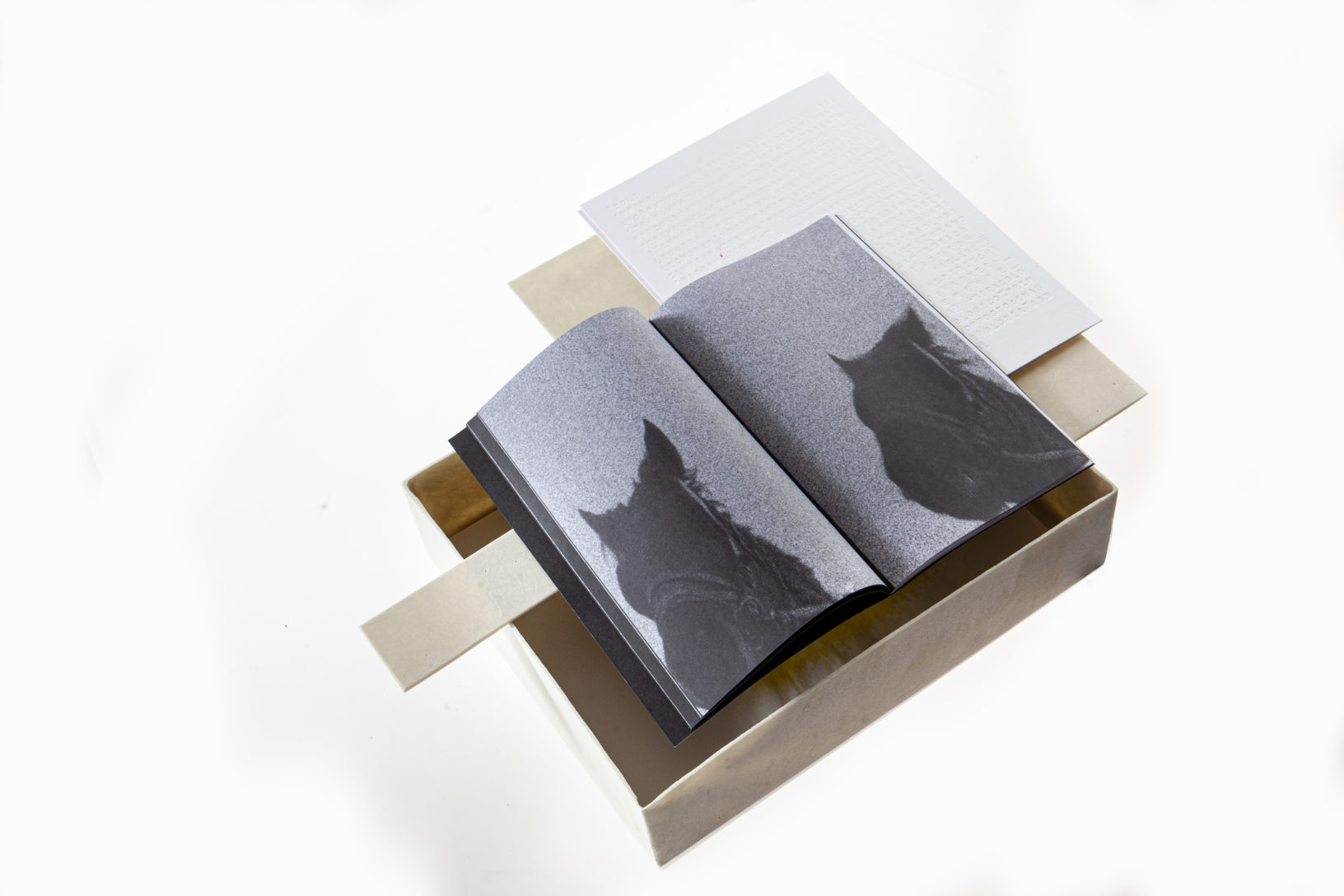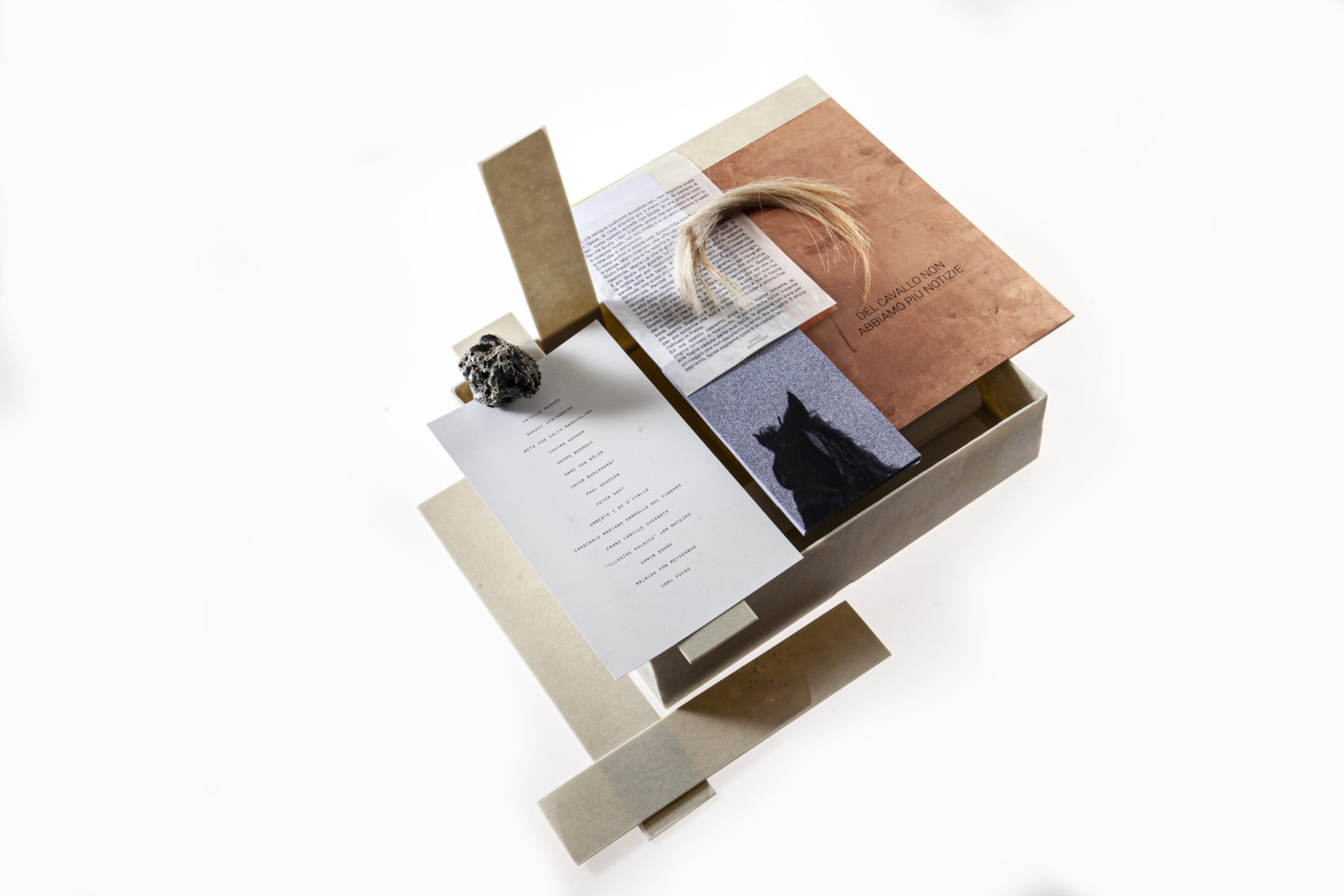Giulia Marchi, artist
Everything move ahead with the strongest of time, multiplo, 2019
Turin, winter 1888-1889. Friedrich Wilhelm Nietzsche, 44 years old, German, professor of Classical Philology, retired for almost ten years is living in Piazza Carlo Alberto. Here he sees a horse being beaten and whipped by a coachman. The intellectual, since a long time span devoted only to philosophy and music, runs towards the animal, embraces it and faints to the ground. From now on Nietzsche would have never recovered from mental illness: the wide and complex project Tutto procede con un tempo fortissimo stem from that episode. The core of my research focuses on the so-called “tickets to madness”, twenty-one letters, whose content is mostly incomprehensible, that Nietzsche wrote and addressed to key figures, once he partially recovered from his major fit of madness. Madness that fully encompasses the concept of Dionysian on which he had widely worked on: a case in which life and thought merge into a phenomenal unicum. Proceeding through a scientific approach to the letters, I approach them as if they were codex to decipher and then I produce 21 zincographic plates then printed on white cotton paper; the result are modern “Rosetta Stone”, an old Egyptian granodiorite stone paramount in deciphering the hieroglyphic writing. Decoding them I then choose 100 words that I use in 4 letters written by myself to relevant people in my life. The project is heterogeneous and structured; during the workflow I was guided by many materials and contaminations. Not only the writing of the letters, I was concerned also with the philosopher great passion to music as well as a research on the horse episode in filmography; I deepened the understanding of this episode thanks to the 2011 film by Béla Tarr and Ágnes Hranitzky The horse of Turin (A torinói ló), in which the initial reference to Friederich Nietzsche develops into a sad story of incommunicability among men. I choose to order these materials in a multiple fiberglass box ( 9 copies), following a “good neighborhood” rule in order to avoid undervaluation of any of them and highlight the overall value of them as a totality: it is a sort of Duchampian “boite en valise”.
On which fields of knowledge are you focused?
Reading, philosophy, music, cinema, photography.
What is the object of your research?
My research focuses on the ability to know how to recognize the value of an artistic operation in its wholeness; I am constantly looking for a code/rule that would allow to manage my “white space” in a concrete way and to find a body in the absence of identifying the zero point of my practice. I follow an analytical approach in order to find an order. The ability to analyze and the will to avoid ignoring it underlie my artistic work.
Could you identify some constants in your work?
The constant and systematic study of the texts are cornerstones of my artistic practice. My approach might as well be called archaeological: I analyze the work process in a surgical way and nothing is left to chance; the fragile balance that underlies the research and the delicate mechanics of knowing how to entangle things highly fascinate me.
How did you find out about Aby Warburg’s work? What interests you the most?
I perfectly remember my first meeting with Warburg … An article published on Il Sole 24 ore on a Sunday in September 2015 (which I still keep); “Books have won at the Warburg Institute” I was taken by its reading for the strength expressed on the value of books and their conservation.
How would you define an Atlas?
Atlas is above all the name of one of the Titans who in mythology holds the weight of the world on his shoulders. I firmly believe that the Atlas can be conceived as an organ of power. Having the possibility of accessing an Atlas strengthens our research and above all allows us to concentrate in just one place what is useful to us. Atlas is a great conquest linked to space.
Atlas as a conceptual, formal and mnemonic device; do you use it in your work? And if so, how?
The concept of Atlas is fundamental in my work. Memory is selective and it is such during the entire processes, the Atlas allows me to locate and organize my work process hierarchically.
Do you know about the existence of Mnemotechnics?
Yes.
Which mnemonic system guides the organization of your material?
My mnemonic rules are connections, that I imagine as an architecture. Everything starts from the first floor: here I place the “archetypes” of what I want to remember and then gradually ascending the floors the connections grow dim to the extent that even diametrically opposite topics do connect.
Are there visual and emotional formulas (pathosformeln) in your project?
I feel that as time passes the reading of a work is never the same, its contextualization and the variables dictated by the passing time have taught me to be always open to changes and reinterpretations.
My pathosformel is related to the ways I approach projects more than to formal elements, although the recurrence of linguistic or visual codes is there changing and adapting to various studies addressed.
In your work, do you identify formal or conceptual recurrences such as repetitions and disruption, distance and proximity, identity and migration, conflict and colonization?
Conceptually, I am interested and attracted by the antinomies that often emerge in my work.
In your work, what is the balance between image and text?
The balance lies exactly in the ability to make them coexist and this depends on the “synapses” that I try to identify between image and text. I am not interested in perfection, but in the strength of the unfinished; formally the balance is given by waiting for the other, depending on each other.
Starting from the ‘good neighborhood rule’, what are the books that underpin your project?
Friedrich W.Nietzsche, Lettere da Torino, Adelphi Edizioni , 2008
George G.Byron , Manfred, Einaudi 2000
Anacleto Verrecchia, La catastrofe di Nietzsche a Torino, Einaudi 1978
Lazlo Krasznahorkai , Melanconia della resistenza, Bompiani 1989
Lazlo Krasznahorkai, Satantango, Bompiani 1985
Nicola Gardini, Lacuna Saggio sul non detto, Piccola Biblioteca Einaudi 2014
Simon Winchester, Il professore e il pazzo, Adelphi edizioni 2018
Giulia Marchi is born in Rimini (1976). She studied Classical Letters at the University of Bologna. She has an artistic background with a strong literary imprint that has led her to an expressiveness that is often characterized by narration, even when the chosen form (often photography, but not only) does not make the reading so immediate, but refers to subsequent combinations, like codes that even before being deciphered allow themselves to be interpreted by a sort of fascination, both for the wise use of materials and for the communicative nature of the image, often deceptive at first glance, but equally attributable to the artist’s poetics. Everything in the creative process is connected, intertwined, characterized by an unequivocal research and by filiation processes that are sometimes difficult to identify. With her work, she aspires to a totality, an attitude to feel the image before even understanding it. Contaminating the art scene with materials of different nature is an integral part of the artist’s work. Photographing is reflection; it requires and demands knowledge, study and deep understanding. The work is not only visual but transcends the vision, leading to tactile spaces in which the image is shaped by subtending a well-structured thought yet to be decoded. To quote Italo Calvino I could think of Giulia’s work in these terms: “The eye does not see things, but figures of things meaning things“. (The invisible cities) Literary research and conceptual approach are precise stylistic features of her photographic language – from the use of the pinhole to the material construction of her own cameras, from the experimentation conducted by chemically treating the polaroid matrices to the constant reference to the text, the starting point and key to understanding through which she paints her rarefied landscapes. – Angela Madesani




